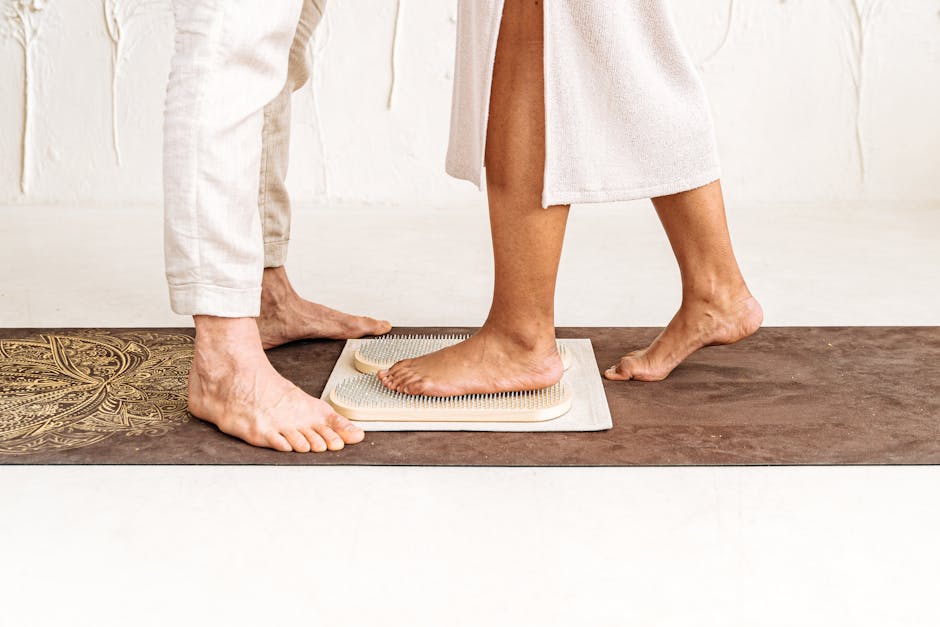Practicing mindful movement in everyday life is like discovering a hidden treasure chest of calm and clarity amidst the hustle and bustle.
By incorporating mindful movement into your routine, you can transform mundane activities into moments of peace and presence.
Keep reading to learn how to weave mindfulness into your daily movements, making each step, bite, and breath a journey of awareness.
Key Takeaways
- Mindful movement involves being present and aware during physical activities.
- It offers numerous benefits, including stress reduction and improved emotional well-being.
- Simple practices like mindful walking, eating, and breathing can be easily integrated into daily life.
- Incorporating mindful movement into self-care routines enhances relaxation and sleep quality.
- Mindful movement can support emotional regulation and overall mental health.
Introduction to Mindful Movement
Definition of Mindful Movement
Mindful movement is the art of bringing awareness to your body as it moves.
It’s about being present in the moment, noticing sensations, and connecting with your breath.
Whether you’re walking, stretching, or simply breathing, mindful movement transforms ordinary actions into extraordinary experiences.
Benefits of Practicing Mindful Movement
The benefits of mindful movement are as vast as the ocean.
It can reduce stress, improve focus, and enhance emotional well-being.
By practicing mindfulness, you can cultivate a sense of peace and balance, even in the midst of chaos.
Mindful movement also promotes physical health by encouraging gentle exercise and body awareness.
Overview of Mindful Movement Practices
Mindful movement practices are diverse and adaptable.
They include activities like yoga, tai chi, and walking meditation.
These practices encourage you to slow down, breathe deeply, and move with intention.
By incorporating mindful movement into your life, you can create a sanctuary of calm wherever you are.

Starting Small with Mindful Movement
Importance of Beginning with Manageable Movements
Starting small is key to building a sustainable mindful movement practice.
Begin with simple, manageable movements that fit into your daily routine.
This approach makes it easier to stay consistent and gradually deepen your practice.
Techniques to Foster a Consistent Practice
Consistency is the secret sauce of mindful movement.
Set aside a few minutes each day for mindful activities.
Whether it’s a short walk or a breathing exercise, regular practice helps you develop mindfulness as a habit.
Setting Realistic Goals
Setting realistic goals keeps you motivated and on track.
Start with small, achievable goals, and gradually increase the complexity of your practice.
Celebrate your progress and remember that mindfulness is a journey, not a destination.

Mindful Movement Practices for Daily Life
Mindful Walking Down The Street Technique
Mindful walking is like a mini-vacation for your mind.
As you walk, focus on each step, the sensation of your feet touching the ground, and the rhythm of your breath.
Steps to Practice Mindful Walking
- Find a quiet place to walk.
- Walk slowly, paying attention to each step.
- Notice the sensations in your feet and legs.
- Breathe deeply and stay present.
Benefits of Mindful Walking
Mindful walking can reduce stress, improve focus, and enhance your connection to the present moment.
It’s a simple yet powerful way to incorporate mindfulness into your daily routine.
Mindful Eating for Four Minutes
Mindful eating turns meals into a sensory experience.
By savoring each bite, you can enhance your awareness and enjoy your food more fully.
How to Practice Mindful Eating
- Choose a small portion of food.
- Eat slowly, focusing on the taste, texture, and aroma.
- Chew thoroughly and savor each bite.
- Notice how your body feels as you eat.
Enhancing Awareness During Meals
Mindful eating helps you develop a healthier relationship with food.
It encourages you to listen to your body’s hunger and fullness cues, promoting mindful consumption.
The 3-Minute Breathing Space
The 3-minute breathing space is a quick mindfulness exercise that can be done anywhere.
It’s a great way to reset and refocus during a busy day.
Quick Mindfulness Exercise
- Find a comfortable position.
- Close your eyes and take a deep breath.
- Focus on your breath, noticing each inhale and exhale.
- Continue for three minutes, staying present with your breath.
Integrating Breathing Space into Daily Routine
Incorporating the 3-minute breathing space into your daily routine can help you manage stress and stay grounded.
It’s a simple yet effective way to practice mindfulness on the go.

Incorporating Mindful Movement into Self-Care
A Soothing Yoga Flow to Help You Choose Yourself
Yoga is a beautiful way to practice mindful movement and self-care.
A gentle yoga flow can help you connect with your body and mind, promoting relaxation and well-being.
Benefits of Gentle Yoga Routines
Gentle yoga routines can reduce stress, improve flexibility, and enhance mental clarity.
They provide a nurturing space for self-reflection and self-compassion.
Steps for a Self-Care Yoga Practice
- Find a quiet space and roll out your mat.
- Begin with a few deep breaths to center yourself.
- Move through a series of gentle poses, focusing on your breath and body.
- End with a few minutes of meditation or relaxation.
Rest in the Movement of Nature
Connecting with nature is a powerful way to practice mindfulness.
Whether you’re walking in the park or sitting by a river, nature offers a soothing backdrop for mindful movement.
Connecting with Nature for Mindfulness
Nature provides a sense of peace and tranquility that enhances mindfulness.
By spending time outdoors, you can deepen your connection to the present moment.
Techniques for Outdoor Mindful Movement
- Find a natural setting that resonates with you.
- Engage in a mindful activity, such as walking or stretching.
- Focus on the sights, sounds, and sensations around you.
- Breathe deeply and enjoy the beauty of nature.

Mindful Movement for Relaxation and Sleep
5 Stretches to Ease Your Body into Sleep
Mindful stretching before bed can help you relax and prepare for a restful night’s sleep.
These stretches are designed to release tension and promote relaxation.
Specific Stretches for Relaxation
- Child’s Pose
- Cat-Cow Stretch
- Seated Forward Bend
- Legs-Up-The-Wall Pose
- Reclining Bound Angle Pose
Creating a Bedtime Routine with Mindful Movement
Incorporating mindful movement into your bedtime routine can improve sleep quality and help you unwind after a long day.
It’s a gentle way to transition from wakefulness to rest.
Practice the Power of the Long Exhale
The long exhale is a powerful breathing technique for relaxation.
By extending your exhale, you can activate the body’s relaxation response and reduce stress.
Breathing Techniques for Relaxation
- Inhale deeply through your nose.
- Exhale slowly through your mouth, extending the exhale.
- Repeat for several breaths, focusing on the sensation of relaxation.
Enhancing Mindful Movement with Breath Control
Breath control enhances the benefits of mindful movement by promoting relaxation and focus.
It’s a simple yet effective way to deepen your mindfulness practice.
Mindful Movement for Emotional Well-being
Mindfulness Techniques for Depression
Mindful movement can support emotional well-being by promoting self-awareness and emotional regulation.
It’s a valuable tool for managing depression and enhancing mental health.
Role of Mindful Movement in Emotional Regulation
Mindful movement encourages you to tune into your emotions and respond with compassion.
It helps you develop a greater understanding of your emotional landscape.
Practical Techniques for Emotional Well-being
- Practice mindful breathing to calm your mind.
- Engage in gentle movement, such as yoga or tai chi.
- Reflect on your emotions with curiosity and kindness.

Conclusion
Recap of Mindful Movement Benefits
Mindful movement offers a treasure trove of benefits, from stress reduction to improved emotional well-being.
By incorporating mindfulness into your daily routine, you can transform ordinary activities into moments of peace and presence.
Encouragement to Incorporate Mindful Movement into Daily Life
Embrace the journey of mindful movement and discover the joy of being present in each moment.
Whether you’re walking, eating, or breathing, mindfulness can enhance your life in countless ways.
Final Thoughts on Developing a Mindful Movement Practice
Developing a mindful movement practice is a journey of self-discovery and growth.
By starting small and staying consistent, you can cultivate a deeper connection to yourself and the world around you.
So take a deep breath, step forward, and embrace the beauty of mindful movement.
For more insights on practicing mindfulness, check out this resource.
And if you’re interested in exploring more about mindful movement practices, this article is a great place to start.
Additionally, for tips on incorporating meditation into daily life, this guide offers valuable advice.
Discover the Art of Mindful Movement: Your Go-To FAQ for Everyday Practice
What is mindful movement and how does it differ from regular exercise?
Mindful movement is a practice that involves bringing awareness to the body and its movements, focusing on the present moment. Unlike regular exercise, which often emphasizes physical outcomes like strength or endurance, mindful movement prioritizes the connection between mind and body, promoting relaxation and mental clarity.
How can I incorporate mindful movement into my daily routine?
Incorporating mindful movement into your daily routine can be as simple as dedicating a few minutes each day to focus on your breath and body movements. You can start with activities like mindful walking, yoga, or tai chi, paying close attention to how your body feels and moves in space.
What are the benefits of practicing mindful movement?
Practicing mindful movement can lead to numerous benefits, including reduced stress, improved mental clarity, and enhanced emotional well-being. It can also increase body awareness, improve posture, and promote a sense of calm and relaxation.
Can mindful movement help with stress management?
Yes, mindful movement is an effective tool for stress management. By focusing on the present moment and tuning into your body’s sensations, you can reduce stress levels and promote a sense of calm. This practice encourages relaxation and helps to break the cycle of stress-related tension.
Is mindful movement suitable for everyone, regardless of fitness level?
Mindful movement is suitable for individuals of all fitness levels, as it can be adapted to meet personal needs and abilities. The practice emphasizes gentle, intentional movements, making it accessible to beginners and those with physical limitations.
How can I stay motivated to practice mindful movement regularly?
To stay motivated, set realistic goals and incorporate mindful movement into activities you already enjoy. You can also join a class or find a community that shares your interest, providing support and accountability. Remember to celebrate small achievements and focus on the positive effects on your well-being.
What are some examples of mindful movement exercises?
Examples of mindful movement exercises include yoga, tai chi, qigong, and mindful walking. These activities emphasize slow, deliberate movements and focus on the connection between breath and body, promoting mindfulness and relaxation.
How long should a mindful movement session last?
The duration of a mindful movement session can vary based on personal preference and schedule. Beginners might start with 5-10 minutes a day, gradually increasing the time as they become more comfortable. Consistency is key, so aim for regular practice rather than focusing solely on duration.
Can mindful movement be practiced at work or in other non-traditional settings?
Absolutely! Mindful movement can be practiced in various settings, including at work. Simple exercises like mindful stretching or breathing can be done at your desk or during breaks, helping to reduce stress and improve focus throughout the day.
What resources are available to learn more about mindful movement?
There are numerous resources available to learn more about mindful movement, including online classes, books, and mobile apps. Many yoga studios and community centers offer classes that focus on mindfulness, providing guidance and support for those interested in exploring this practice further.



